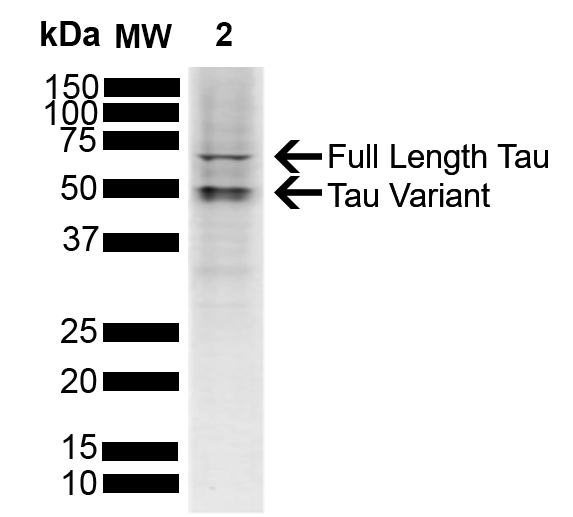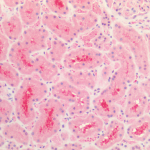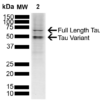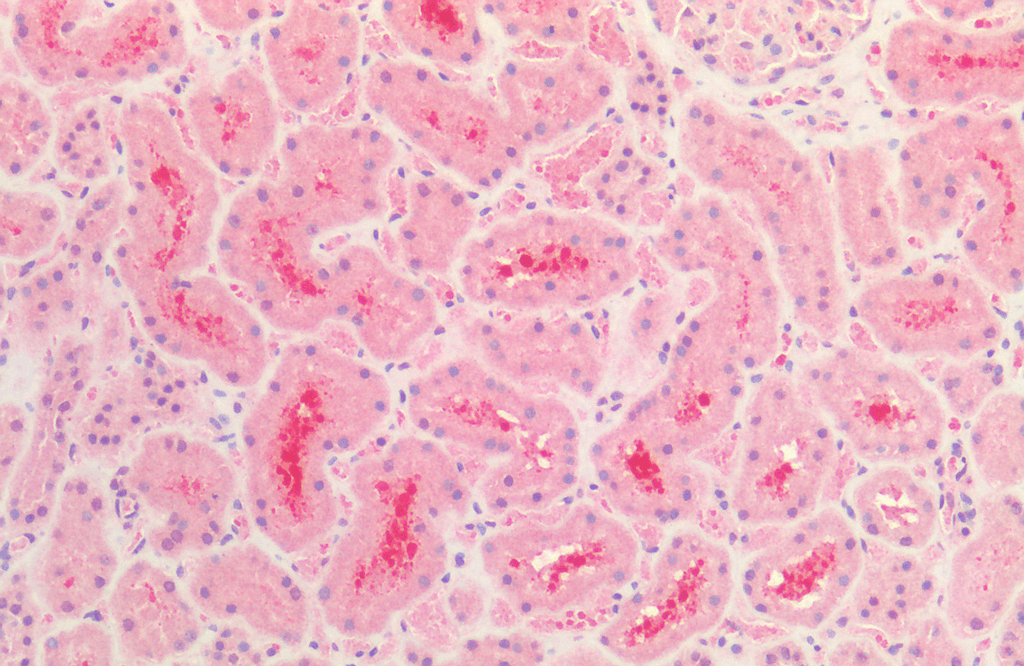Properties
| Storage Buffer | PBS pH 7.4, 50% glycerol, 0.09% sodium azide *Storage buffer may change when conjugated |
| Storage Temperature | -20ºC, Conjugated antibodies should be stored according to the product label |
| Shipping Temperature | Blue Ice or 4ºC |
| Purification | Protein A purified |
| Clonality | Polyclonal |
| Specificity | Detects ~45.8kda. |
| Cite This Product | Rabbit Anti-Human Tau Polyclonal (StressMarq Biosciences, Victoria BC, Cat# SPC-801) |
| Certificate of Analysis | A 1:1000 dilution of SPC-801 was sufficient for detection of Tau in 10 μg of human SH-SY5Y cell lysate cell lysates by ECL immunoblot analysis using goat anti-rabbit IgG:HRP as the secondary antibody. |
Biological Description
| Alternative Names | Tau Antibody, Neurofibrillary tangle protein Antibody, MAPTL Antibody, Microtubule-associated protein tau Antibody, MTBT1 Antibody, Paired helical filament-tau Antibody, TAU Antibody, PHF-tau Antibody, MAPT Antibody, AI413597 antibody, AW045860 antibody, DDPAC antibody, FLJ31424 antibody, FTDP 17 antibody, G protein beta1/gamma2 subunit interacting factor 1 antibody, MAPT antibody, MAPTL antibody, MGC134287 antibody, MGC138549 antibody, MGC156663 antibody, Microtubule associated protein tau antibody, Microtubule associated protein tau isoform 4 antibody, Microtubule-associated protein tau antibody, MSTD antibody, Mtapt antibody, MTBT1 antibody, MTBT2 antibody, Neurofibrillary tangle protein antibody, Paired helical filament tau antibody, Paired helical filament-tau antibody, PHF tau antibody, PHF-tau antibody, PPND antibody, PPP1R103 antibody, Protein phosphatase 1, regulatory subunit 103 antibody, pTau antibody, RNPTAU antibody, TAU antibody, TAU_HUMAN antibody, Tauopathy and respiratory failure, included antibody |
| Research Areas | Alzheimer's Disease, Axon Markers, Cell Markers, Cell Signaling, Cytoskeleton, Microtubules, MT Associated Proteins, Neurodegeneration, Neuron Markers, Neuroscience, Tangles & Tau |
| Cellular Localization | Axolemma, Axolemma Plasma Membrane, Axon, Cell Body, Cell membrane, Cytoplasm, Cytoplasmic Ribonucleoprotein Granule, Cytoplasmic Side, Cytoskeleton, Cytosol, Dendrite, Growth cone, Microtubule, Microtubule Associated Complex, Neurofibrillary Tangle, Neuronal Cell Body, Nuclear Periphery, Nuclear Speck, Nucleus, Peripheral membrane protein, Plasma Membrane, Tubulin Complex |
| Gene ID | 4137 |
| Swiss Prot | P10636 |
| Scientific Background | Alzheimer’s Disease (AD) is the most common neurodegenerative disease, affecting 10% of seniors over the age of 65 (1). It was named after Alois Alzheimer, a German scientist who discovered tangled bundles of fibrils where neurons had once been in the brain of a deceased patient in 1907 (2). Tau (tubulin-associated unit) is normally located in the axons of neurons where it stabilizes microtubules. Tauopathies such as AD are characterized by neurofibrillary tangles containing hyperphosphorylated tau fibrils (3). There are six isoforms of tau in the adult human brain: three with four repeat units (4R) and three with three repeat units (3R) (4). K18 is a truncated form of human tau containing only the 4 microtubule binding repeats (5). P301L (PL) is a mutation where proline is replaced by leucine at codon 301 of tau, and has been linked to frontotemporal dementia (6). |
| References |
1. www.alz.org/alzheimers-dementia/facts-figures 2. Alzheimer, A. Über eine eigenartige Erkrankung der Hirnrinde. Allg. Z. Psychiatr. Psych.-Gerichtl. Med. 64, 146–148 (1907) 3. Matsumoto, G. et al. (2018). Int J Mol Sci. 19, 1497. 4. Goedert, M. and Spillantini, M. G. (2017). Mol Brain. 10:18. 5. Guo, J. and Lee, M.Y. (2013). FEBS Lett. 587(6): 717-723. 6. Alberici, A. et al. (2004). J Neurol Neurosurg Psychiatry. 75:1607-1610. |
Product Images

Western blot analysis of SH-SY5Y showing detection of ~45.8 kDa Tau protein using Rabbit Anti-Tau Polyclonal Antibody (SPC-801). Lane 1: Molecular Weight Ladder (MW). Lane 2: SH-SY5Y. Load: 10 µg. Block: 5% Skim Milk powder in TBST. Primary Antibody: Rabbit Anti-Tau Polyclonal Antibody (SPC-801) at 1:1000 for 2 hours at RT with shaking. Secondary Antibody: Goat anti-rabbit IgG:HRP at 1:4000 for 1 hour at RT with shaking. Color Development: Chemiluminescent for HRP (Moss) for 5 min in RT. Predicted/Observed Size: ~45.8 kDa. Other Band(s): 50 kDa, 65 kDa.
























Reviews
There are no reviews yet.